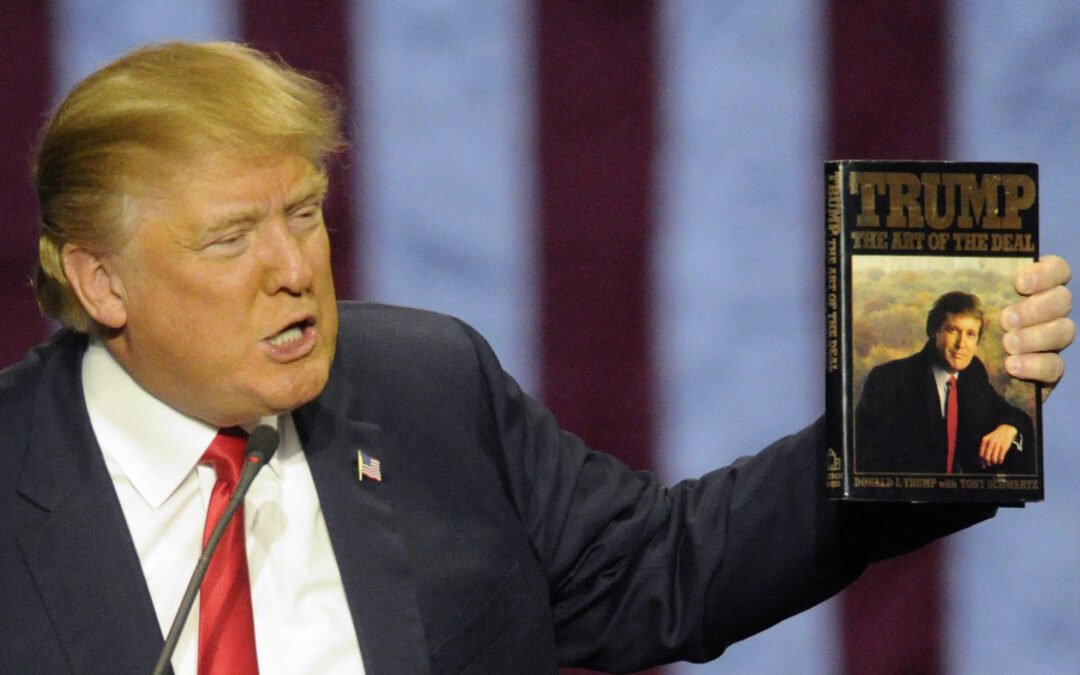? Book Summary: The Art of the Deal
Author: Donald J. Trump (with Tony Schwartz)
Published: 1987
Genre: Business / Autobiography
Core Theme: How Trump thinks, negotiates, and wins in business through strategy, persuasion, and relentless confidence.
The book blends autobiography, business advice, and philosophy of winning. Trump uses his real estate deals from the 1970s–80s (especially in New York City) to illustrate how he approaches opportunity, risk, and success.
Key Takeaways
- Big Thinking and Vision
- Trump believes in thinking big. Mediocrity, in his view, is more dangerous than risk.
- He says: “If you’re going to be thinking anyway, you might as well think big.”
- He constantly frames himself as a visionary — someone who sees opportunity where others see problems.
- Self-Promotion and Branding
- The Trump name is treated as a brand — synonymous with luxury, success, and confidence.
- He uses media strategically to shape public perception. Long before social media, Trump was a master of publicity.
- Negotiation and Power Dynamics
- The book emphasizes leverage: always know what the other side wants, and use that to your advantage.
- He mixes boldness with psychological manipulation — staying unpredictable, confident, and even intimidating when needed.
- A core idea: “Use your leverage. Know your value and don’t be afraid to walk away.”
- Persistence and Resilience
- Trump glorifies relentless work ethic and refusal to quit.
- He claims that setbacks are temporary and that failure only happens when you stop trying.
- His mindset turns problems into “tests of character.”
- Intuition Over Analysis
- Trump often relies on gut instinct more than data or research.
- He says he trusts his intuition about people, deals, and timing — a reflection of his spontaneous, risk-taking style.
- Winning as Identity
- Winning isn’t just a goal; it’s his identity.
- He defines success in visible, measurable outcomes — money, fame, buildings, and public recognition.
- Losing, or appearing weak, is something he avoids at all costs.
? Analysis: How Trump’s Mind Works
“The Art of the Deal” is more than a business manual — it’s a psychological map of Trump’s mindset. Here’s how his thinking patterns emerge through the text:
- Dominance and Control
Trump thrives on control — of people, outcomes, and narratives. He’s obsessed with being the one who sets the terms.
? This reflects a dominance-driven mindset, often seen in high-performing entrepreneurs and negotiators.
- Strategic Confidence (Borderline Overconfidence)
He projects confidence even when unsure. This is a deliberate tactic — to influence others’ perceptions.
? Psychologically, this blends self-belief, risk tolerance, and image construction.
- Emotional Detachment
Trump rarely discusses emotions, empathy, or collaboration. His focus is on results, not relationships.
? This detachment helps him make bold moves without fear, but can lead to transactional relationships.
- Narrative Construction
He views life as a story he controls — shaping his image to fit his ambitions.
? He instinctively uses storytelling to build myth and credibility (e.g., “I saw potential where no one else did”).
- Win-Lose Thinking
Trump’s worldview is competitive, not cooperative. Someone must lose for him to win.
? This zero-sum mindset drives aggression and ambition but can strain partnerships.
- Gut-Driven Decision-Making
Rather than relying on detailed analysis, he trusts his intuition and sense of timing.
? This works when instincts are sharp, but can backfire in complex, data-heavy scenarios.
- Ego as Fuel
Trump’s ego isn’t hidden — it’s the engine of his ambition.
? His need for recognition drives his productivity and persistence, but also makes him sensitive to criticism.
? Psychological Summary
| Trait | Description | How It Shows in the Book |
| Confidence | Unshakable self-belief | He positions himself as always in control |
| Risk-Taking | Prefers big, bold moves | “I like thinking big. I always have.” |
| Self-Promotion | Constant brand building | Uses media attention strategically |
| Aggression | Dominance in negotiation | Pressures opponents psychologically |
| Visionary Thinking | Seeing opportunities others miss | Transforms old buildings into luxury icons |
| Low Empathy | Pragmatic focus on profit | Rarely discusses moral or emotional aspects |
| Resilience | Thrives under stress | Turns obstacles into public triumphs |
? In Simple Terms — How Trump’s Mind Works
- He thinks like a showman and a warrior.
Every deal is a performance, every move a contest to win. - He sees perception as reality.
If people believe he’s winning, he is winning — because that belief shapes outcomes. - He values loyalty, but only if it serves the mission.
Relationships are strategic, not sentimental. - He measures success in visibility and victory.
To him, recognition and results are the ultimate proof of worth. - He operates on instinct, speed, and confidence.
Analysis is secondary; momentum and presence are primary.
? Final Insight
“The Art of the Deal” is essentially a window into Trump’s psychological formula for success:
Big Vision + Relentless Confidence + Strategic Manipulation + Media Mastery.
He doesn’t see business as numbers — he sees it as psychological warfare, where the most confident and persistent person wins.

